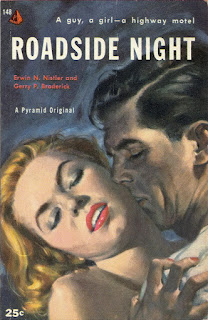 Jules Feiffer
Jules Feiffer, the Pulitzer Prize-winning American cartoonist and author, passed away last week at age 95. Cause of death: congestive heart failure. “[He] left an abundant legacy across a range of artistic media,” Etelka Lehoczky
recalls in an obituary for National Public Radio. “The history of graphic art, literature, film and the theater bear the imprint of his ever-distinctive, ever-wayward pen.”
But Feiffer is most familiar to the most people for his artwork, whether it be his satirical cartoons, his comic strips, or his illustrations, many of them reprinted in books, such as 1958’s
Sick, Sick, Sick: A Guide to Non-Confident Living. In addition, however, he left behind two novels: 1963’s
Harry the Rat with Women and 1977’s
Ackroyd, the latter of which is subtitled “A Mystery of Identity.”
On The Thrilling Detective Web Site, Kevin Burton Smith calls it
a rather strange book, taking the form of the diary of Robert Hollister, a neurotic young man who has decided to become a private eye named Roger Ackroyd (a tip of the fedora to Agatha Christie’s classic The Murder of Roger Ackroyd) by posting an ad in the Saturday Review. But Robert/Roger becomes obsessed with one of his very first clients, Oscar “Rags” Plante, a newspaper sports columnist/novelist and his wife Annabelle, whose parakeet has gone missing.
The case? Investigate the bad case of writer’s block that Rags claims he’s suffering from.
Smith explains that this book “covers several years of Robert/Roger’s (and Oscar’s) life, and as their characters slowly merge, we’re treated to a sort of blurry (but often amusing) existential crisis.”
I read
Ackroyd decades ago, and still have the 1978 Avon paperback edition featured above, though I can’t seem to lay my hands on it just now. When I started writing this post, I logically assumed that
Ackroyd’s cover must have been painted by Feiffer; he did, after all, create the fronts for other books (Norton Juster’s
The Phantom Toolbooth being a prime example). Yet that was incorrect. There’s a signature at the bottom of the illustration, and it clearly reads “
Stanislaw Fernandes.” Fernandes is an artist, born in 1945, who I know best for
his science-fiction and fantasy covers.
 (Above) Stanislaw Fernandes’ signature on Ackroyd.
(Above) Stanislaw Fernandes’ signature on Ackroyd.
Never in a million years would I have guessed that Feiffer’s “funny, but not funny enough” novel (to quote Smith again) would have shared a cover artist with classics by Arthur C. Clarke, Stanislaw Lem, and Michael Moorcock. The world never ceases to surprise.
LISTEN UP: “
Remembering Pulitzer Prize-winning Cartoonist Jules Feiffer” (National Public Radio’s
Fresh Air).

















